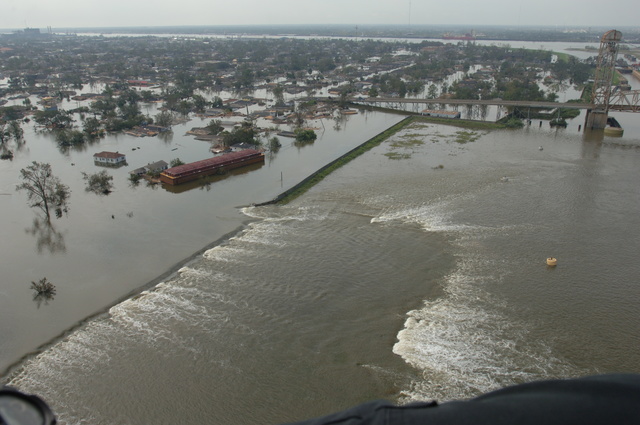Levee
| Line 8: | Line 8: | ||
[https://www.ciria.org/Resources/Free_publications/I_L_H/ILH_resources.aspx The International Levee Handbook], published by CIRIA in 2013, defines levee as: "Raised, predominantly earth, structures (sometimes called flood defence embankments or dikes) whose primary objective is to provide protection against fluvial and coastal flood events along coasts, rivers and artificial waterways that are not reshaped under normal conditions by the action of waves and currents. Levees form part of flood defence systems that may also include flood walls, pumping stations, closure structures, natural features, etc." | [https://www.ciria.org/Resources/Free_publications/I_L_H/ILH_resources.aspx The International Levee Handbook], published by CIRIA in 2013, defines levee as: "Raised, predominantly earth, structures (sometimes called flood defence embankments or dikes) whose primary objective is to provide protection against fluvial and coastal flood events along coasts, rivers and artificial waterways that are not reshaped under normal conditions by the action of waves and currents. Levees form part of flood defence systems that may also include flood walls, pumping stations, closure structures, natural features, etc." | ||
| − | + | As stated in the CIRIA definition (and outside of engineering applications), the terms levee and dyke are sometimes used interchangeably. However, the terms are not technically the same. | |
| − | + | Dykes are usually permanent structures that are built in areas that are located below sea level and are thus uninhabitable. Their placement reclaims land to make it fit for use. Levees can be permanent structures, such as those built from cement, or temporary structures which might be made from stone, earth or sandbags. | |
| − | + | There are also geograph/cultural preferences. For instance, in the state of Louisiana (which is vulnerable to flooding of rivers prompted by hurricanes), the term levee is most frequently used. In the lowlands of the Netherlands (which have been reclaimed from the sea), dyke is the common term. | |
See dyke. | See dyke. | ||
| + | |||
| + | In Ancient Egypt, levees were used along the Nile to protect the surrounding valleys and to irrigate the land. They were also used in other Ancient cultures such as Mesopotamia, where farmers built earthen levees to prevent the rivers from flooding their fields. | ||
= Related articles on Designing Buildings Wiki = | = Related articles on Designing Buildings Wiki = | ||
Revision as of 16:38, 30 June 2021
|
In August 2005, Hurricane Katrina caused the levees to break. This sent floodwaters into neighbourhoods in New Orleans, Louisiana. This aerial photograph shows the break in the levee in the 9th ward. Photo courtesy of Jocelyn Augustino/FEMA. |
The International Levee Handbook, published by CIRIA in 2013, defines levee as: "Raised, predominantly earth, structures (sometimes called flood defence embankments or dikes) whose primary objective is to provide protection against fluvial and coastal flood events along coasts, rivers and artificial waterways that are not reshaped under normal conditions by the action of waves and currents. Levees form part of flood defence systems that may also include flood walls, pumping stations, closure structures, natural features, etc."
As stated in the CIRIA definition (and outside of engineering applications), the terms levee and dyke are sometimes used interchangeably. However, the terms are not technically the same.
Dykes are usually permanent structures that are built in areas that are located below sea level and are thus uninhabitable. Their placement reclaims land to make it fit for use. Levees can be permanent structures, such as those built from cement, or temporary structures which might be made from stone, earth or sandbags.
There are also geograph/cultural preferences. For instance, in the state of Louisiana (which is vulnerable to flooding of rivers prompted by hurricanes), the term levee is most frequently used. In the lowlands of the Netherlands (which have been reclaimed from the sea), dyke is the common term.
See dyke.
In Ancient Egypt, levees were used along the Nile to protect the surrounding valleys and to irrigate the land. They were also used in other Ancient cultures such as Mesopotamia, where farmers built earthen levees to prevent the rivers from flooding their fields.
Related articles on Designing Buildings Wiki
- Coastal defences.
- Dyke
- Flood.
- River engineering.
- The history of conservation areas
- Water engineering.
- Waterway.
Featured articles and news
Infrastructure that connect the physical and digital domains.
Harnessing robotics and AI in challenging environments
The key to nuclear decommissioning and fusion engineering.
BSRIA announces Lisa Ashworth as new CEO
Tasked with furthering BSRIA’s impressive growth ambitions.
Public buildings get half a million energy efficiency boost
£557 million to switch to cleaner heating and save on energy.
CIOB launches pre-election manifesto
Outlining potential future policies for the next government.
Grenfell Tower Inquiry announcement
Phase 2 hearings come to a close and the final report due in September.
Progress from Parts L, F and O: A whitepaper, one year on.
A replicated study to understand the opinion of practitioners.
ECA announces new president 2024
Electrical engineer and business leader Stuart Smith.
A distinct type of countryside that should be celebrated.
Should Part O be extended to existing buildings?
EAC brands heatwave adaptation a missed opportunity.
Definition of Statutory in workplace and facilities management
Established by IWFM, BESA, CIBSE and BSRIA.
Tackling the transition from traditional heating systems
59% lack the necessary information and confidence to switch.
The general election and the construction industry
As PM, Rishi Sunak announces July 4 date for an election.
Eco apprenticeships continue help grow green workforce
A year after being recognised at the King's coronation.
Permitted development rights for agricultural buildings
The changes coming into effect as of May 21, 2024.






















